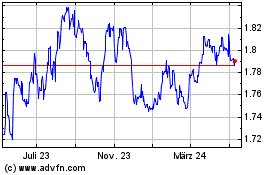NZ Dollar Falls On Disappointing Business Confidence Data
30 Juni 2015 - 6:45AM
RTTF2
The New Zealand dollar weakened against the other major
currencies in the Asian session on Tuesday, after data showed that
nation's business confidence turned negative in June.
The ANZ business outlook report showed that New Zealand's
business confidence turned negative for the first time since the
major Christchurch earthquake in February 2011. The business
confidence fell markedly to -2.3 from 15.7 in the previous month.
The survey showed a net 2 percent of businesses were pessimistic
about the general economy.
The fall of average price for dairy products, the nation's
largest commodity export, to the lowest level since August 2009 on
the benchmark GlobalDairyTrade auction, prompted the farmer
confidence to slump to the lowest level in a decade in the second
quarter.
Meanwhile, the Reserve Bank of New Zealand estimates a quarter
of dairy farmers are operating in negative cash flow.
In other economic news, Statistics New Zealand reported that the
total number of building permits issued in New Zealand was roughly
unchanged in May, standing at 2,171. That follows the upwardly
revised 0.9 percent decline in April.
On a yearly basis, the number of permits climbed 2.2
percent.
Ongoing worries about the looming threat of a Greek debt default
and the possibility of the debt-laden country exiting the eurozone
also dampened sentiment.
Greece and its creditors have failed to reach an agreement on a
deal to release bailout funds in time for Greece to meet a 1.6
billion euro debt payment to the International Monetary Fund due
later this day.
Greek Prime Minister Alexis Tsipras reportedly said on Monday
that his country will not make the payment to the IMF by the
Tuesday deadline unless Greece strikes a deal with its
creditors.
Monday, the NZ dollar showed mixed trading against its major
rivals. While the kiwi fell against the U.S. dollar and the yen, it
rose against the euro and the Australian dollar.
In the Asian trading today, the NZ dollar fell to a 1-week low
of 1.6437 against the euro and a 6-day low of 1.1264 against the
Australian dollar, from yesterday's closing quotes of 1.6398 and
1.1205, respectively. If the kiwi extends its downtrend, it is
likely to find support around 1.67 against the euro and 1.14
against the aussie.
Against the U.S. dollar and the yen, the kiwi dropped to 0.6807
and 83.38 from yesterday's closing quotes of 0.6848 and 83.92,
respectively. On the downside, 0.66 against the greenback and 81.00
against the yen are seen as the next support level for the
kiwi.
Looking ahead, Japan housing starts and construction orders for
May is due to be released at 1:00 am ET.
Subsequently in the European session, German retail sales for
may is slated for release at 2:00 am ET. Additionally, Swiss KOF
leading indicator for June, German unemployment rate for June,
third estimate of U.K first quarter GDP, U.K. index of services for
April and flash Eurozone CPI for June and unemployment rate for May
are also set to be announced.
At 4:40 am ET, Reserve Bank of Australia Governor Glenn Stevens
is expected to speak at an event hosted by the Official Monetary
and Financial Institutions Forum in London.
Around the same time, Bank of England's Paul Fisher will deliver
a speech at the Financial Times Future of Insurance event, in
London
In the New York session, Canada GDP for April, U.S.
S&P/Case-Shiller home price index for April, U.S. Chicago PMI
and U.S. consumer confidence, both for June, are set to be
published
At 7:00 am ET, Bank of England Chief Economist Andy Haldane is
expected to speak at the Open University in London.
An hour later, European Central Bank Governing Council member
Ewald Nowotny will give a keynote speech at "Raiffeisen Bank
International-Summer Talk" in Vienna.
Euro vs NZD (FX:EURNZD)
Forex Chart
Von Apr 2024 bis Mai 2024

Euro vs NZD (FX:EURNZD)
Forex Chart
Von Mai 2023 bis Mai 2024
